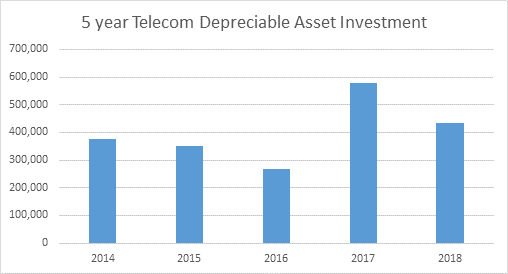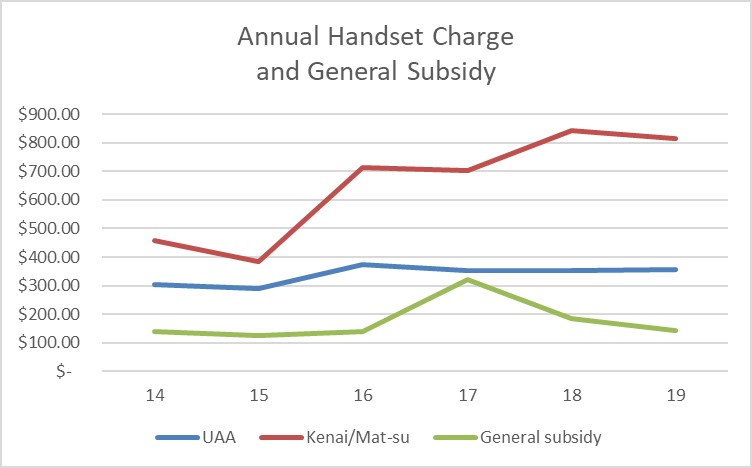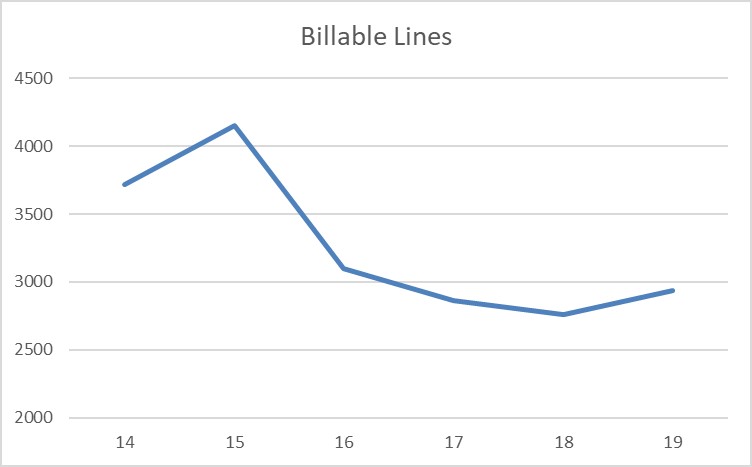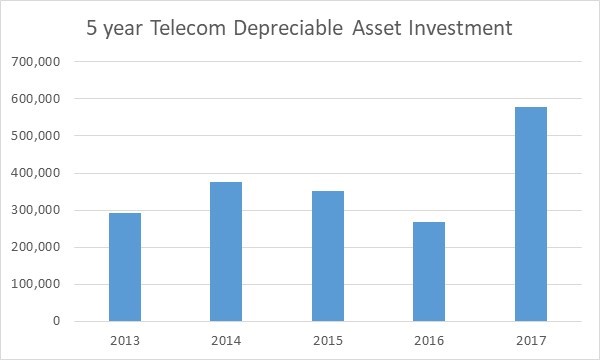Reports
Telecommunications at UAA
Annual Reports
This inaugural report provides an enhanced view of the largest area of revenue and expense within UAA Information Technology. Telecommunications used to represent basic phone services, but now incorporates a wide array of technologies and services used by students, faculty, and staff to connect, learn, and communicate. The goal of the report is provide transparency around the services, projects, and financials encompassing the telecommunications area.
Network access is a fundamental component of teaching and learning in the 21st century. UAA has a robust network infrastructure, providing a number of services for connecting students, faculty, and staff within UAA, community campuses and the UA system as well as to individuals and services far beyond campus. The service is managed to ensure minimal downtime while also being cost effective.
Telecommunications at UAA FY18 Annual Report
See below for a list of services provided by the telecommunications service.
Please select header for more information on each section.
- WirelessHigh speed wireless access is available throughout the UAA Anchorage campus, community campuses, and UAA buildings throughout the Anchorage metro area. Over 600 access points are currently deployed and are accessed by students, faculty, and staff using their UA credentials. Access points can provide speeds of up to 1-gigabyte/second. Public access is available in select areas of campus, at reduced speeds, and does not require UA credentials.
- Wired Network AccessHigh speed wired access is provided to faculty, student, and staff offices, classrooms, and select common areas at 1-gigabyte speeds. Copper and fiber optic connections between buildings ensure high-speed secure connectivity to the UAA data center, the internet, between buildings, and other UA campuses.
- Internet AccessUAA students, faculty, and staff have access to multiple internet access paths. The primary connection provides 1-gigabyte of access, while a specialized Internet2 connection provides 10 gigabytes. Student housing provides a dedicated 500 megabyte internet connection over wireless. In addition, internet connectivity over Wi-Fi is provided by GCI at somewhat slower speeds throughout common areas on campus.
- Emergency CommunicationsEmergency communications are a core capability of the telecommunications service, with several methods of communication available. Phones are programmed to ensure correct location information is relayed to the Anchorage emergency dispatch center when a 911 call is placed. Campus wide communication capability is available in an emergency via the phone based Informacast system. Campus emergency phones (blue phones) are located throughout campus and route directly to the University Police Department dispatch center. Most classrooms have phones available for emergency communications. Uninterruptible power supplies are part of the phone infrastructure, ensuring voice communications continue to be available for a period of time in the event of a power outage.
- Basic TelephoneBasic telephone service provides voice-calling capability throughout all UAA and community campus buildings and includes voicemail, long distance, and other common features such as forwarding, caller id, and speed dial. Free long distance calling is provided to other campuses in the UA system by simply dialing the 7-digit destination phone number.
- Specialty TelephoneThe UAA voice infrastructure provides advanced features for call centers, such as call queuing, menu trees, call routing, queue music, and advanced reporting. The University Police Department has a specialized phone system to enhance public safety. In addition, specialized lines are available for building controls, elevators, and other equipment with unique telephony needs.
- Network Security and MonitoringNetwork security is a fundamental component of computing and telecommunications at UAA and is informed by state and federal laws and regulation such as FERPA and HIPAA. Components throughout the network monitor data traffic and restrict access, as necessary. Specialized networks protect sensitive data and equipment, and ensure credit card transactions are protected by meeting payment card industry standards (PCI). Secure access to internal networks over the internet is provided by the VPN (virtual private network) service. Copyright protection issues are detected and investigated.
- Switchboard and DirectoryCalls to the University’s main line are answered during business hours. Callers often have general questions or need assistance finding a particular individual, college, or department. The campus directory is available on UAA’s website and provides contact information for faculty, staff, and departments.
- Advanced VOIP and Web Conferencing ToolsSkype for Business provides advanced communications for all faculty, staff, and students. Features include web video and audio conferencing, connections to the public switched telephone network, toll free access, instant messaging, presence, screen sharing, and meeting scheduling.
Projects
The telecommunications service is continuously updated to ensure a high level of reliability and quality. The service includes a depreciation component so the infrastructure can be refreshed and maintained over time. Several projects are undertaken each year. Projects in FY18 include:
Please select project name for more information.
- Wireless Expansion and ModernizationThe wireless infrastructure has been upgraded over the past several years to support digital classrooms and enhanced teaching and learning. Over 300 access points have been added or upgraded since 2013, with over 30 added and over 100 upgraded in FY18. Wireless controllers have been upgraded to enhance speed, reliability, and security, as well as add new options for self service and special event access.
- Campus Backbone UpgradeUAA has a high-speed connection between the east and west sides of campus. This backbone is being upgraded to 8-times the previous bandwidth, and buildings are being upgraded to connect at 10-times the previous bandwidth.
- UPS UpgradesUninterruptible power supplies (UPS) are a core system component to ensure power interruptions do not interrupt critical campus communications. UPSs are deployed throughout the main campus, off campus buildings, and community campuses and require periodic replacement. 10% of the UPS infrastructure was replaced in FY18 with an additional 10% planned for FY19.
- BillingSeveral changes were made in FY18 to simplify billing and reduce the overhead associated with the telecommunications recharge. Billing departments back for long distance was eliminated in January of 2018. Starting July 1, 2018, monthly billing was eliminated in favor of annual billing.
Financial Snapshot
The telecommunications service at UAA is funded through a combination of the network access fee charged at 4% of tuition with 2% retained by UAA, and department user fees currently allocated by the number of telephone handsets in use. Telecommunications is formally designated as a recharge, with rates set annually and a goal of breaking even. Prior to recent cuts by the legislature, a general fund subsidy was allocated to the recharge to keep handset charges at a lower rate. This subsidy has since been eliminated with some carryforward currently being allocated while rates eventually normalize at a higher level. Telecommunications staff regularly employ new technologies and processes to keep costs of the service in check while expanding capabilities and access.
FY18 High Level Financial Overview (in thousands)

UAA has a significant plant and equipment investment to support all aspects of the telecommunications service. Regular investment is necessary to ensure the service remains modern and can meet current communications expectations. The increase in 2018 over the recent average reflects network security upgrades.


Handset charges are a significant source of revenue to support the service. Kenai and Mat-su retain the network fee charged on their tuition, reflecting a separate handset rate. Rates increased in 2016 as the main campus student housing removed most handsets due to changing student preferences. Rates for all users will continue to normalize at a higher rate as the general subsidy is reduced due to budget pressures.
Telecommunications at UAA FY17 Annual Report
See below for a list of services provided by the telecommunications service.
Please select header for more information on each section.
- WirelessHigh speed wireless access is available throughout the UAA Anchorage campus, community campuses, and UAA buildings throughout the Anchorage metro area. Over 600 access points are currently deployed and are accessed by students, faculty, and staff using their UA credentials. Access points can provide speeds of up to 1-gigabyte/second. Public access is available in select areas of campus, at reduced speeds, and does not require UA credentials.
- Wired Network AccessHigh speed wired access is provided to faculty, student, and staff offices, classrooms, and select common areas at 1-gigabyte speeds. Copper and fiber optic connections between buildings ensure high-speed secure connectivity to the UAA data center, the internet, between buildings, and other UA campuses.
- Internet AccessUAA students, faculty, and staff have access to multiple internet access paths. The primary connection provides 1-gigabyte of access, while a specialized Internet2 connection provides 10 gigabytes. Student housing provides a dedicated 500 megabyte internet connection over wireless. In addition, internet connectivity over Wi-Fi is provided by GCI at somewhat slower speeds throughout common areas on campus.
- Emergency CommunicationsEmergency communications are a core capability of the telecommunications service, with several methods of communication available. Phones are programmed to ensure correct location information is relayed to the Anchorage emergency dispatch center when a 911 call is placed. Campus wide communication capability is available in an emergency via the phone based Informacast system. Campus emergency phones (blue phones) are located throughout campus and route directly to the University Police Department dispatch center. Most classrooms have phones available for emergency communications. Uninterruptible power supplies are part of the phone infrastructure, ensuring voice communications continue to be available for a period of time in the event of a power outage.
- Basic TelephoneBasic telephone service provides voice-calling capability throughout all UAA and community campus buildings and includes voicemail, long distance, and other common features such as forwarding, caller id, and speed dial. Free long distance calling is provided to other campuses in the UA system by simply dialing the 7-digit destination phone number.
- Specialty TelephoneThe UAA voice infrastructure provides advanced features for call centers, such as call queuing, menu trees, call routing, queue music, and advanced reporting. The University Police Department has a specialized phone system to enhance public safety. In addition, specialized lines are available for building controls, elevators, and other equipment with unique telephony needs.
- Network Security and MonitoringNetwork security is a fundamental component of computing and telecommunications at UAA and is informed by state and federal laws and regulation such as FERPA and HIPAA. Components throughout the network monitor data traffic and restrict access, as necessary. Specialized networks protect sensitive data and equipment, and ensure credit card transactions are protected by meeting payment card industry standards (PCI). Secure access to internal networks over the internet is provided by the VPN (virtual private network) service. Copyright protection issues are detected and investigated.
- Switchboard and DirectoryCalls to the University’s main line are answered during business hours. Callers often have general questions or need assistance finding a particular individual, college, or department. The campus directory is available on UAA’s website and provides contact information for faculty, staff, and departments.
- Advanced VOIP and Web Conferencing ToolsSkype for Business provides advanced communications for all faculty, staff, and students. Features include web video and audio conferencing, connections to the public switched telephone network, toll free access, instant messaging, presence, screen sharing, and meeting scheduling.
Projects
The telecommunications service is continuously updated to ensure a high level of reliability and quality. The service includes a depreciation component so the infrastructure can be refreshed and maintained over time. Several projects are undertaken each year. Projects in FY17 include:
Please select project name for more information.
- Rasmussen Hall Re-CableThe cabling in RH did not meet modern specifications, making communications unreliable. Modern cabling was installed in the second and third floors during the fall semester of 2016. Work on the first floor began in the summer of 2017 with final completion to be accomplished during the fall semester.
- Wireless Expansion and ModernizationThe wireless infrastructure has been upgraded over the past several years. Over 250 access points have been added or upgraded since 2013, with over 50 added or upgraded in FY17. In addition, controllers have upgraded to enhance speed, reliability, and security, as well as add new options for self service and special event access.
- Campus Backbone UpgradeUAA has a high-speed connection between the east and west sides of campus. This backbone is being upgraded to 8-times the previous bandwidth, and buildings are being upgraded to connect at 10-times the previous bandwidth.
- Phone System UpgradeThe phone system requires software and hardware upgrades to ensure reliability and compatibility with handsets and integrated software such as Informacast. Both the system hardware and software were upgraded in FY17, requiring significant time and effort. The upgrade fixed several bugs and significantly modernized the system.
- UPS UpgradesUninterruptible power supplies (UPS) are a core system component to ensure power interruptions do not interrupt critical campus communications. UPSs are deployed throughout the main campus, off campus buildings, and community campuses and require periodic replacement. 10% of the UPS infrastructure was replaced in FY17 with an additional 10% planned for FY18.
Financial Snapshot
The telecommunications service at UAA is funded through a combination of the network access fee charged at 4% of tuition with 2% retained by UAA, and department user fees currently allocated by the number of telephone handsets in use. Telecommunications is formally designated as a recharge, with rates set annually and a goal of breaking even. Prior to recent cuts by the legislature, a general fund subsidy was allocated to the recharge to keep handset charges at a lower rate. This subsidy has since been eliminated with some carryforward currently being allocated while rates eventually normalize at a higher level. Telecommunications staff regularly employ new technologies and processes to keep costs of the service in check while expanding capabilities and access.
FY17 High Level Financial Overview (in thousands)
 UAA has a significant plant and equipment investment to support all aspects of the
telecommunications service. Regular investment is necessary to ensure the service
remains modern and can meet current communications expectations. The increase in
2017 over the recent average reflects the purchase of equipment required to upgrade
the main campus backbone.
UAA has a significant plant and equipment investment to support all aspects of the
telecommunications service. Regular investment is necessary to ensure the service
remains modern and can meet current communications expectations. The increase in
2017 over the recent average reflects the purchase of equipment required to upgrade
the main campus backbone.

Handset charges are a significant source of revenue to support the service. Kenai and Mat-su retain the network fee charged on their tuition, reflecting a separate handset rate. Rates increased in 2016 as the main campus student housing removed most handsets due to changing student preferences. Rates for all users will continue to normalize at a higher rate as the general subsidy is reduced due to budget pressures.









